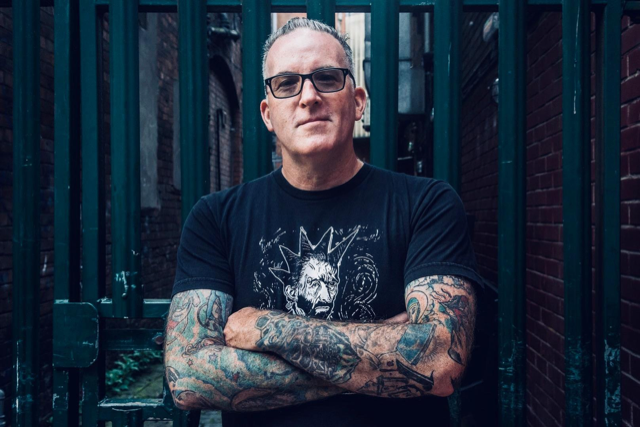
For the last two decades, Jim Ruland has balanced unpredictable forays into fiction with detailed looks into punk rock history. Last year saw the release of his book Corporate Rock Sucks, a comprehensive look at the history of SST Records. This year, he’s followed that up with Make It Stop, set in a near future where the nation’s for-profit healthcare system has taken a turn for the all-controlling and a group of activists seek to dismantle the system via a host of techniques. I talked with Ruland about the way his fiction and nonfiction shape one another and his penchant for unlikely genre cross-pollination.
Your last novel, Forest of Fortune, combined elements of both horror and crime fiction. Meanwhile, Make It Stop has an interesting balance of noir and speculative storytelling. What draws you to finding interesting places between genres and carving out your own space within them?
I think it comes from reading comic books when I was a kid. When I first got into comics the titles I’d find on spin racks at the drugstore were straightjacketed into genre: super hero, sword and sorcery, horror, war, etc. As my passion intensified and I got deeper into the lore of these worlds the more I appreciated those places where they intersected. Marvel even had a series called What If… With titles like What If… Wolverine battled Conan the Barbarian? That shit blew my tiny little mind and I’ve been drawn to those kinds of counterfactual collisions ever since.
Do you have any particular favorite works that enter into that space between science fiction and noir storytelling?
The films Blade Runner, The Fifth Element, Twelve Monkeys. The comic 2000 AD. I’m definitely drawn to stories where characters are trapped by the technology they embrace, which feels like the engine that makes Black Mirror run.
The storyline of Make it Stop explores and critiques elements of recovery, for-profit medicine, consolidation in the health care industry, and activism. Did you have all of that in mind from the beginning, or were there real-world events that ended up making their way into the near future setting of your book?
It’s kind of a mix of both. I had the whole concept at the beginning. I read a story in the LA Times about a maternity hospital in Nigeria that was holding mothers hostage until their bill was paid. I thought something like that could never happen here in the U.S… (LOL) I was newly sober and so I applied that scenario to the drug and alcohol rehab and recovery complex and Make It Stop was born. Over the next ten years I wrote numerous drafts and wasn’t able to execute a story that lived up to its promise. Then two things happened: I rewatched Fight Club and read Vote with a Bullet: Assassination in American Fiction. These texts sharpened my understanding of Make It Stop as a story of vigilantism and helped me create a world where violent activism was essential for survival.
Were there any cases where something you’d envisioned as a speculative element came to pass as you were writing Make it Stop?
It’s funny that you ask. One word of advice I would give to anyone writing a novel set in the near future is don’t take a decade to write it! In any case, the Truthbot’s pronouncements on the dating app she uses – TruLuv.com – feels like a foretaste of AI that’s dominating the discourse these days.
Your last work of nonfiction was Corporate Rock Sucks, a very different look at larger-than-life personalities, complicated corporate structures, and contradictory worldviews. Did the writing of these two projects have any overlap?
They did. Prior to the pandemic I adapted My Damage, the book I wrote with Keith Morris, into a screenplay and had an absolute blast. That experience convinced me I would be able to find the flaws in Make It Stop by adapting it, and it did. I spent the lockdown working on Corporate Rock Sucks but every so often I’d go back to Make It Stop and try to turn it back into a novel. I traded chapters with J.D. O’Brien who was also adapting a screenplay he’d written about heist at a weed dispensary that goes unpredictably awry, which made me feel a little less crazy. Happily, his novel was published around the same time as Make It Stop and I heartily recommend Zig-Zag to readers who like their crime capers with a comic touch.
Melanie’s forays into online dating — and the online dating app that she uses — made for some of the most emotionally unnerving parts of the book. (And tapped into some of my own deeply-held fears about The Apps.) Was there a part of writing this novel that left you especially unsettled?
One of the pitfalls for addicts in recovery is the danger of replacing one addictive behavior with another: sex, food, work, video games, etc. Melanie’s spiral into the dark side of dating apps reflects this compulsion and it’s definitely caused me to question the way I use and consume (and am used and consumed by) social media.
What was the most challenging part of writing Make It Stop?
I struggled with everything. I struggled with the mechanics of the story. I struggled with Melanie’s sobriety. I struggled with the political dimension. This isn’t War and Peace. It’s not a book that should have taken ten years to figure out, but it did. That desire to be done with the book was so strong, so powerful, and it fooled me, on more than one occasion, into thinking that it was finished when it wasn’t. I’d say the most challenging thing was accepting there was more work to be done, five, seven, nine years into the project. Ultimately, I felt like I owed it to Melanie to get it right.
Follow Vol. 1 Brooklyn on Twitter, Facebook, and sign up for our mailing list.
